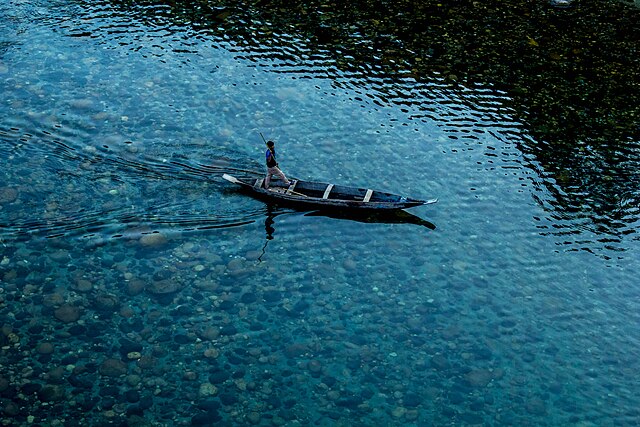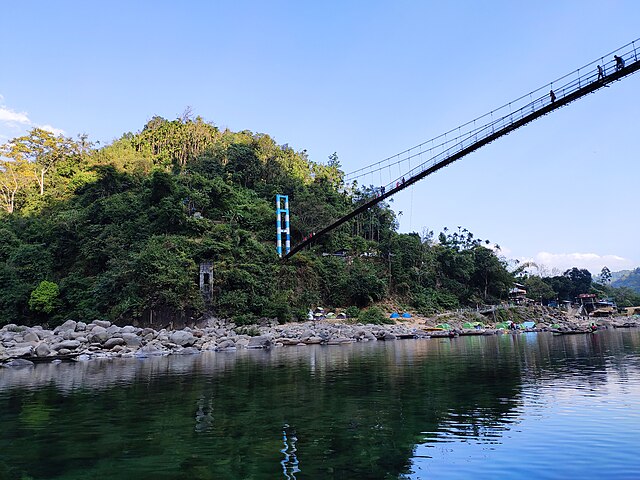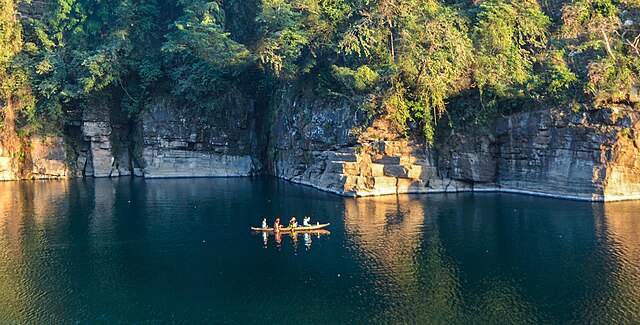Have you ever seen water so clear that boats appear to be floating in mid-air? Welcome to the magical world of Umngot River, where nature has crafted one of India’s most breathtaking aquatic wonders. Nestled in the picturesque state of Meghalaya, this pristine river has become a sensation on social media and a must-visit destination for travelers seeking untouched natural beauty.
What Makes Umngot River Special?
The Umngot River isn’t just another waterway – it’s a natural phenomenon that challenges everything you thought you knew about Indian rivers. Unlike the murky waters we’re accustomed to seeing, this river boasts crystal-clear transparency that allows you to see the riverbed even at considerable depths. It’s like nature’s own glass cathedral, flowing through the lush landscapes of Meghalaya.
The Geography Behind the Magic
Located in the West Jaintia Hills district of Meghalaya, the Umngot River flows through Dawki town before crossing into Bangladesh. The river originates from the hills of Meghalaya and travels approximately 60 kilometers before joining the Surma River in Bangladesh. What makes this geographical journey special is the unique geological composition of the region.
The river flows over a bed of limestone and sandstone, which naturally filters the water and contributes to its exceptional clarity. The absence of industrial pollution and the minimal human interference in its upper reaches have preserved its pristine condition. Think of it as nature’s own water purification system, working tirelessly for centuries.
Why Is the Water So Clear?
The secret behind Umngot River’s crystal-clear waters lies in a perfect combination of factors. First, the river’s source is in the relatively unpolluted hills of Meghalaya, where industrial activities are minimal. Second, the limestone bed acts as a natural filter, removing impurities as the water flows downstream.
The river’s flow rate also plays a crucial role. During the monsoon season, the increased water flow helps flush away any sediments, while in the dry season, the reduced flow allows the water to settle and maintain its clarity. It’s like having a self-cleaning mechanism that keeps the water sparkling clean year-round.
Location and How to Reach Umngot River
The Umngot River flows through Dawki, a small border town in Meghalaya, approximately 96 kilometers from Shillong, the state capital. This strategic location makes it accessible to travelers while maintaining its pristine character away from major urban centers.
Getting to Dawki
Your journey to the Umngot River begins with reaching Dawki town. If you’re flying in, the nearest airport is Lokpriya Gopinath Bordoloi International Airport in Guwahati, Assam, about 130 kilometers away. From there, you can hire a taxi or take a bus to reach Dawki.
For those preferring train travel, Guwahati Railway Station is the nearest major railway station. From Guwahati, the road journey to Dawki takes approximately 3-4 hours, depending on traffic and road conditions. The route itself is scenic, passing through rolling hills and traditional villages.
Transportation Options
Once you reach Shillong, you have several options to get to Dawki. Shared taxis and buses run regularly between Shillong and Dawki, making it an affordable option for budget travelers. Private taxis offer more comfort and flexibility, allowing you to stop at scenic spots along the way.
If you’re feeling adventurous, consider renting a motorcycle or scooter in Shillong. The ride to Dawki is absolutely spectacular, with winding roads offering panoramic views of the Meghalayan landscape. Just remember to check your vehicle’s condition and carry necessary documents.
Best Time to Visit Umngot River

Timing your visit to Umngot River can make the difference between a good trip and an unforgettable experience. The river’s character changes dramatically with the seasons, offering different experiences throughout the year.
Weather Patterns Throughout the Year
Meghalaya experiences a subtropical highland climate, with three distinct seasons affecting the Umngot River differently. The summer months (March to May) offer pleasant weather with temperatures ranging from 15°C to 25°C. This is when the river is at its clearest, with minimal rainfall ensuring maximum transparency.
The monsoon season (June to September) transforms the entire region into a lush green paradise. However, heavy rainfall can make the river water slightly turbid due to increased flow and sediment movement. The post-monsoon period (October to February) is ideal, with clear skies, pleasant weather, and the river returning to its crystal-clear state.
Peak Tourist Season vs. Off-Season Benefits
The peak tourist season runs from October to March when the weather is most favorable and the river is at its clearest. During this time, you’ll find the best conditions for photography, boating, and other water activities. However, this also means higher accommodation costs and more crowded attractions.
Visiting during the off-season (April to September) has its own advantages. You’ll encounter fewer tourists, better deals on accommodation, and a more intimate experience with nature. The monsoon season, while challenging for some activities, offers spectacular waterfalls and lush green landscapes that are equally mesmerizing.
Things to Do at Umngot River
The Umngot River offers a variety of activities that cater to different interests and adventure levels. Whether you’re a thrill-seeker or someone who prefers peaceful contemplation, this natural wonder has something for everyone.
Boating Adventures
The most popular activity at Umngot River is undoubtedly boating. Local operators offer various types of boats, from traditional wooden boats to modern speed boats. The experience of gliding over crystal-clear water where you can see the riverbed below is truly magical.
Traditional rowing boats are perfect for a leisurely exploration of the river. You can take your time, stop for photographs, and truly appreciate the pristine beauty of your surroundings. For those seeking more excitement, speed boats offer an adrenaline-pumping ride across the wider sections of the river.
Photography Opportunities
Umngot River is a photographer’s paradise, offering countless opportunities for stunning shots. The crystal-clear water creates perfect reflections of the surrounding hills and sky, while the floating boats create surreal images that seem almost otherworldly.
The best photography spots include the area around Dawki Bridge, where the contrast between the concrete structure and the natural beauty creates compelling compositions. Early morning and late afternoon provide the best lighting conditions, with soft golden light enhancing the river’s natural beauty.
Swimming and Water Activities
The clean, clear waters of Umngot River make it an ideal spot for swimming and other water activities. The river’s depth varies, with shallow areas perfect for families with children and deeper sections for more confident swimmers.
River rafting is another exciting option, though it’s more popular during the monsoon season when water levels are higher. Local guides can arrange safe rafting experiences suitable for beginners, combining adventure with the opportunity to see the river from a unique perspective.
Safety Guidelines for Water Activities
While the Umngot River is generally safe for water activities, it’s important to follow basic safety guidelines. Always wear life jackets when boating or engaging in water sports. Be aware of the current, which can be stronger during monsoon season, and never swim alone.
Local guides are familiar with the river’s conditions and can provide valuable safety advice. They know the best and safest spots for different activities and can help ensure your experience is both enjoyable and secure.
The Famous Dawki Bridge
No visit to Umngot River is complete without experiencing the famous Dawki Bridge, which has become an iconic symbol of the region’s natural beauty and strategic importance.
History and Significance
The Dawki Bridge, officially known as the Dawki-Tamabil Bridge, was constructed to facilitate trade and movement between India and Bangladesh. Built over the Umngot River, this bridge serves as a crucial link in the region’s transportation network.
The bridge gained international attention when photographs of boats appearing to float in mid-air beneath it went viral on social media. These images showcased the remarkable clarity of the Umngot River, bringing global recognition to this hidden gem in Meghalaya.
Border Trade Hub
Dawki serves as an important border trade hub between India and Bangladesh. The bridge witnesses a constant flow of goods and people, making it a vibrant center of cross-border commerce. Visitors can observe the bustling trade activities while enjoying the scenic beauty of the river below.
The border crossing experience itself is unique, with immigration procedures conducted in a relatively relaxed atmosphere compared to other international borders. However, visitors should carry proper identification documents and be prepared for routine security checks.
Accommodation Options Near Umngot River

Finding suitable accommodation near Umngot River requires some planning, as the area is still developing its tourism infrastructure. However, several options cater to different budgets and preferences.
Budget-Friendly Stays
Dawki town offers several budget-friendly guesthouses and lodges that provide basic amenities at affordable prices. These accommodations are typically family-run establishments that offer a chance to experience local hospitality and culture.
Shnongpdeng village, located a few kilometers from Dawki, has emerged as a popular base for budget travelers. The village offers camping facilities and basic homestays that provide an authentic experience of rural Meghalayan life.
Luxury Resorts and Homestays
For those seeking more comfort, several luxury resorts and upscale homestays have been established in the region. These accommodations offer modern amenities while maintaining harmony with the natural environment.
Many of these properties are located on hillsides overlooking the river, providing spectacular views and easy access to the water. Some resorts offer package deals that include meals, guided tours, and water activities, making them convenient options for travelers.
Local Culture and Traditions
The Umngot River region is inhabited primarily by the Khasi community, one of Meghalaya’s indigenous tribes. Understanding their culture and traditions adds depth to your visit and creates opportunities for meaningful cultural exchange.
The Khasi Community
The Khasi people are known for their matrilineal society, where lineage and inheritance pass through the female line. This unique social structure has preserved many traditional practices and created a society where women play prominent roles in community leadership.
The Khasi community has a deep connection with nature, reflected in their traditional beliefs and practices. They consider rivers, forests, and hills as sacred entities that must be protected and respected. This reverence for nature has contributed to the preservation of the Umngot River’s pristine condition.
Local Festivals and Celebrations
Throughout the year, the Khasi community celebrates various festivals that showcase their rich cultural heritage. The most important festival is Shad Suk Mynsiem, a harvest festival celebrated in April with traditional dance, music, and feasting.
Visitors fortunate enough to witness these celebrations gain insight into the community’s values, traditions, and way of life. The festivals often feature traditional Khasi music, performed on indigenous instruments, and elaborate dances that tell stories of their ancestors and connection to the land.
Environmental Conservation Efforts
The pristine condition of Umngot River is not accidental – it’s the result of conscious conservation efforts by local communities, government agencies, and environmental organizations.
Protecting the River’s Purity
Local communities have implemented strict guidelines to prevent pollution of the river. Industrial activities are prohibited in the river’s catchment area, and waste disposal is carefully regulated. Traditional fishing practices are maintained to ensure the river’s ecosystem remains balanced.
The Meghalaya government has designated the Umngot River area as an eco-sensitive zone, providing legal protection against activities that could harm the river’s pristine condition. Regular monitoring ensures that water quality standards are maintained and any potential threats are addressed promptly.
Sustainable Tourism Practices
Tourism operators in the region are increasingly adopting sustainable practices to minimize their environmental impact. This includes using eco-friendly boats, implementing waste management systems, and educating visitors about responsible tourism.
Visitors are encouraged to follow Leave No Trace principles, ensuring that their presence doesn’t negatively impact the river’s pristine condition. Simple actions like not littering, using biodegradable products, and respecting local guidelines help preserve this natural wonder for future generations.
Photography Tips for Umngot River
Capturing the ethereal beauty of Umngot River requires some technical knowledge and creative vision. Here are some tips to help you create stunning photographs that do justice to this natural wonder.
Best Angles and Lighting
The key to photographing Umngot River is understanding how light interacts with the crystal-clear water. Early morning light creates soft, golden reflections, while late afternoon sun produces dramatic shadows and highlights.
For the famous “floating boat” effect, position yourself on the Dawki Bridge or elevated positions along the riverbank. The contrast between the visible riverbed and the boat creates the illusion of floating, which is most pronounced when the sun is directly overhead.
Equipment Recommendations
A polarizing filter is essential for river photography, as it reduces reflections and enhances the clarity of underwater features. A wide-angle lens helps capture the expansive beauty of the river and surrounding landscape.
For smartphone photographers, consider using HDR mode to capture the full range of light and shadow. Waterproof cases allow you to take photos from unique angles, including partially submerged shots that showcase the water’s clarity.
Nearby Attractions
The Umngot River area offers several additional attractions that can enhance your visit and provide a more comprehensive experience of Meghalaya’s natural beauty.
Shnongpdeng Village
Located about 5 kilometers from Dawki, Shnongpdeng village has become a popular destination for adventure tourism. The village offers river camping, kayaking, and cliff jumping opportunities along the Umngot River.
The village maintains a perfect balance between tourism development and traditional lifestyle preservation. Visitors can experience authentic Khasi culture while enjoying modern adventure activities in a stunning natural setting.
Other Scenic Spots
The region around Umngot River is dotted with other natural attractions worth exploring. The Krang Suri Falls, located about 38 kilometers from Dawki, offers spectacular waterfalls and natural swimming pools with crystal-clear blue water.
Jowai, the district headquarters, provides insight into local administrative and cultural life. The town serves as a base for exploring other attractions in the West Jaintia Hills district, including limestone caves, waterfalls, and traditional villages.
Travel Tips and Essentials
Planning a successful trip to Umngot River requires attention to several practical details that can significantly impact your experience.
What to Pack
Pack light, quick-dry clothing suitable for both water activities and exploring. Waterproof bags are essential for protecting electronics and important documents. Don’t forget sunscreen, insect repellent, and a good pair of water shoes for river activities.
A reusable water bottle helps reduce plastic waste while ensuring you stay hydrated. Pack some snacks, as food options may be limited in remote areas. A basic first aid kit is always recommended for any outdoor adventure.
Local Etiquette
Respect local customs and traditions when interacting with the Khasi community. Ask permission before photographing people, and be prepared to offer a small tip for boat operators and guides. Learning a few basic phrases in Khasi can help create positive interactions with locals.
Be mindful of the environment and follow sustainable tourism practices. Don’t litter, avoid disturbing wildlife, and respect any areas that locals consider sacred or off-limits to tourists.
Conclusion
The Umngot River stands as a testament to nature’s incredible ability to create beauty that seems almost too perfect to be real. This crystal-clear waterway in Meghalaya offers more than just stunning visuals – it provides an opportunity to connect with pristine nature, experience rich cultural traditions, and create memories that last a lifetime.
Whether you’re seeking adventure through water sports, tranquility through boat rides, or cultural enrichment through interactions with the Khasi community, Umngot River delivers an experience that exceeds expectations. The key to enjoying this natural wonder lies in approaching it with respect, following sustainable tourism practices, and remaining open to the magic that unfolds when crystal-clear waters meet the human spirit.
As you plan your visit to this remarkable destination, remember that you’re not just a tourist – you’re a guardian of this pristine ecosystem. Your choices and actions help ensure that future generations can experience the same wonder and beauty that draws visitors from around the world to the banks of India’s clearest river.
Frequently Asked Questions
1. Is it safe to swim in Umngot River?
Yes, swimming in Umngot River is generally safe due to its clean, clear waters. However, always assess current conditions, swim in designated areas, and never swim alone. During monsoon season, be extra cautious as water levels and currents can be stronger.
2. What is the best time of day to visit Umngot River for photography?
Early morning (6-8 AM) and late afternoon (4-6 PM) offer the best lighting conditions for photography. For the famous “floating boat” effect, midday when the sun is directly overhead provides the clearest view of the riverbed through the transparent water.
3. How much does it cost to take a boat ride on Umngot River?
Boat rides typically cost between ₹100-500 per person, depending on the type of boat and duration of the ride. Traditional rowing boats are cheaper than motorized boats. Prices may vary during peak season, so it’s advisable to negotiate with local operators.
4. Can I visit Umngot River as a day trip from Shillong?
Yes, Umngot River can be visited as a day trip from Shillong, though it requires an early start. The journey takes about 2-3 hours each way, leaving you with 4-5 hours to explore the river and surrounding areas. For a more relaxed experience, consider staying overnight in Dawki.
5. Are there any restrictions for foreign tourists visiting Umngot River?
Foreign tourists need to obtain an Inner Line Permit (ILP) to visit Meghalaya, including the Umngot River area. This can be obtained online or at designated government offices. Since Dawki is a border town, carry proper identification documents and be prepared for security checks.

